The evolving CIO role: From IT operator to business strategist
This in-depth guide to the role of the CIO traces the job's evolution, explains what is required of the position today and why it has become so important to businesses.
The role of the chief information officer, or CIO, has evolved significantly in recent decades as technology and digital data have become ubiquitous and vital to business success.
Since its beginnings nearly 40 years ago, the job of an organization's top IT executive has involved the cost-effective and strategic management of IT systems. But today's CIOs must also understand how IT drives business transformation.
No longer just the overseers of IT operations and services, many CIOs are now acting as key business strategists, working with their C-level peers and the board of directors to create the business models necessary to survive -- and thrive -- in the 21st-century digital economy.
"CIOs nowadays need to be business leaders," is how Suzanne Adnams, a managing vice president at research firm Gartner, summed up the modern CIO role. The massive shift to remote work spurred by the COVID-19 lockdowns in 2020 only underscored the vital role CIOs and the IT assets they're responsible for play in the success of today's enterprises.
Recent history has shown that effective CIOs possess the personal skills required to drive large-scale change, such as digital transformation and the adoption of new ways of working. They also have the technical expertise to decide which among the flood of emerging technologies will give their enterprises a business edge. As technology writer Mary Pratt reported in an article on the role of the CIO in 2022, the job "is being shaped by a constellation of new technologies and the business's burning need to use them for competitive advantage." Value generation, business transformation and customer centricity are cited as top priorities of the job by the CIOs and industry watchers Pratt interviewed, along with IT concerns such as cybersecurity and implementing emerging technologies.
"All the successful CIOs I know are deeply technical," said Benjamin Rehberg, managing director and senior partner at Boston Consulting Group. Without a high-level understanding of complex and potentially game-changing technologies, such as blockchain and AI, "you won't have the insights into the opportunities that the technology provides," he said.
So, what exactly is a CIO and how do you get to be one? Our guide to the CIO's place in the modern enterprise takes stock of this multifaceted role, including its history, its relation to other IT executive positions in the C-suite, its chief challenges and its future prospects. Throughout the guide, hyperlinks point to related articles that cover the topics being addressed in more depth.
Part 1: Importance and evolution of the CIO role
The evolution of the CIO job from technology expert to a business strategist with deep technical expertise has arguably been more dramatic than any other C-level role transition. Early heads of the IT function came to their positions by being very good at technology -- mainframe data processing, in particular. By the 1990s, the IT department's top leader had transitioned from being just a data-processing expert to an executive-level arbiter of a company's hardware, software and data management. However, despite burgeoning IT budgets, a C-level title and oversight of companywide systems, late 20th-century CIOs were still largely IT operators rather than business executives. Their IT organizations of highly trained experts were perceived as order takers of the business, not as innovators.
It was not until the first decade of the new millennium -- with the rise of social media, smartphones, the world's largest search engine and the world's largest e-commerce company -- that companies grasped how integral IT was to business strategy and fully appreciated the importance of IT-business alignment. Technology was no longer the exclusive province of IT experts or an add-on for business functions; it was everywhere, it was a normal part of everyday experience and it was changing how business got done. This consumerization of IT marked the turning point for CIOs from overseers of centralized computing to overseers of an enterprise's digital business strategy.
Isaac Sacolick, a former longtime CIO and author of Driving Digital: The Leader's Guide to Business Transformation Through Technology, was a firsthand witness to the shift. When he started out as a young CTO in the 1990s, the CIOs he knew were IT operators -- by necessity. "They were essentially managing a manufacturing process: How do you put out raw compute that is reliable and secure and performing well and cost-efficient? Those were hard problems to solve," said Sacolick, president and CIO of digital transformation consulting firm StarCIO. When the web was created, there was a new set of problems to solve. Now, he concurs that IT operational excellence is necessary but not sufficient for CIOs. "If you look at the CIO role today, it is all about relationships, culture, application development and innovation."
Who coined the term 'CIO'?
The term chief information officer (CIO) was coined by prominent organizational theorists William Synnott and William Gruber in their 1981 book, Information Resource Management: Opportunities and Strategies for the 1980s.
The role was conceived as a top management position. Just as the CFO's purview was finance, the CIO was envisioned as being the corporate-wide information technology strategist.
When they wrote the book, Gruber was an assistant professor of management at the MIT Sloan School of Management and Synnott the head of management information systems at Bank of Boston. They believed the strategic management of information processing by a C-level expert would give the bank a significant competitive advantage.
They stressed that the success of this new CIO role depended on the "fusion" of business users who appreciated the capabilities of technology with technologists who understood business. That would be a long time coming.
History of the CIO role through the decades
To understand the remarkable transformation of the CIO's role, it helps to review IT's top job at some of its major inflection points.
1950s through 1970s: The mainframe era
In the mainframe era, IT's top professionals were the specialized programmers, systems operators and analysts hired to operate the massive machines that gave the era its name. Also known as big iron, mainframes are the expensive, complex computers that debuted in the late 1950s and were used primarily by large companies for high-speed calculations and data crunching. Working in customized, cooled rooms and garbed in white lab coats, IT experts were as remote from the day-to-day business as the powerful machines they operated. Data processing was centralized and done on IT's timetable. The business reports these technology systems of record generated included the monthly payroll, inventory, sales and other back-office transactional data.
1970s through mid-1990s: Distributed computing era
The heyday of the mainframe was followed by what's known as the distributed computing era. While mainframe use continued, the period from the 1970s to the 1990s marked the use of minicomputers and the advent of PCs. Enterprise computing was no longer just for large-scale clerical processing but for gathering and analyzing data to inform business decisions. Data was not just the province of the few but currency for the many, as the adoption of PCs put powerful technology in the hands of employees.
This decentralization of information systems gave rise to IT managers throughout the enterprise -- including businesspeople with IT expertise. At the same time, decentralization highlighted the need for an executive-level technology leader to oversee a function that now touched every part of the enterprise, directly affected how businesses made money and increasingly dictated how employees did their jobs. The term CIO came into use in 1981.
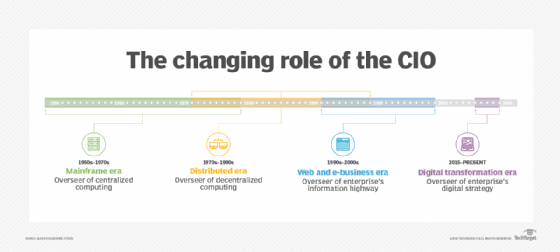
1990s through early 2000s: Web and e-business arrive
CIOs in this period remained responsible for delivering new IT systems on time and on budget, as well as for running existing and new systems with a high degree of reliability. The technical challenges CIOs faced did not abate. The 1990s marked the adoption of the modern enterprise resource planning software suites that collected and managed data produced at different levels of the business. These were costly, complex systems that often required significant business process reengineering. At large companies, there were data centers to build, networks to protect and critical business applications to maintain.
Even as CIO responsibilities expanded, IT continued to be viewed as an expense center rather than an investment in business success. (The idea of IT as an innovation hub was far off.) As a result, CIOs were continually pressured to cut costs and strive to do more with less.
One trend that helped turn around the perception of IT as purely a cost center was the adoption of IT chargeback, an accounting strategy that applies the costs of IT services, hardware and software to the business unit in which they are used. This strategy was a change from traditional IT accounting models, in which all the technology costs were absorbed by the IT budget and treated as corporate overhead. With the chargeback approach, business units could see the implications of the IT decisions they were making.
Another development that changed the role of the CIO and IT was the advent of e-business, the conducting of business processes online, and e-commerce, the buying and selling of goods and services on the web. This opened the door for some CIOs and their IT departments to become more deeply involved in business strategy.
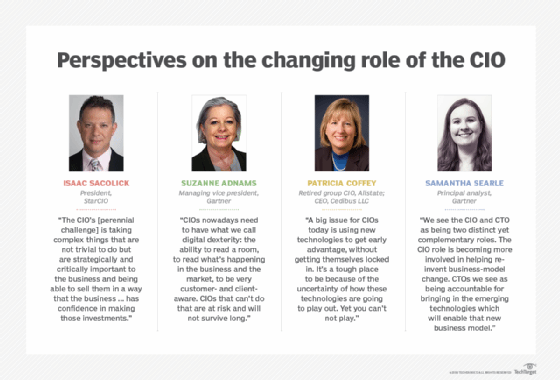
2005 to present: Revolution driven by mobile, cloud, emerging tech and a pandemic
The immensely successful debut of the iPhone in 2007, followed by other consumer-oriented mobile devices, presaged another watershed moment for enterprise IT and the CIO role. These smart devices ushered in the expectation of anytime, anyplace computing, and the irreversible breakdown between work and personal computing -- a culture change CIOs would have to manage. Mobile computing also accelerated the development of a slew of new technologies that would become part of the CIO's purview, including IoT, 5G networks and a new IT architecture known as edge computing.
But the trend that perhaps most radically redefined the CIO role was the advent of enterprise cloud computing services in the early 2000s. Cloud computing companies provided software, infrastructure and platforms as a service to other organizations. The use of cloud shifted IT investment from a capital expense to an operating expense, dramatically cut the time to provision services to business users, and forced CIOs to deal with a new class of vendors. It also gave them more time to focus on strategy and enabled them to spend less time managing internal computing infrastructure.
The rise of cloud providers brought about another big change: They allowed business leaders and workers to easily procure powerful technology without consulting IT managers and the CIO. The potential security risks and integration problems posed by unauthorized, ad hoc technology decisions -- referred to as shadow IT -- highlighted another skill required of effective CIOs. Building trusted relationships with the C-suite, line-of-business leaders and even the board of directors became a vital part of the job. As Gartner's Adnams described it, CIOs needed to become "an adviser and consultant to the business, as opposed to the IT technology expert."
Between 2010 and 2019, the need for digital transformation marked yet another turning point in the role of the CIO and IT, but not without resistance and hardly overnight. Despite the power and reach of digital powerhouses such as Apple, Amazon and Google and the ability of upstarts like Uber and Airbnb to disrupt entire industries, many legacy companies were slow to embark on a so-called digital transformation journey and make the required technology, business process and cultural changes it called for. That reluctance was obliterated by the catastrophe nobody saw coming.
The COVID-19 pandemic set off a mind-boggling acceleration of digital transformation, as companies raced to accommodate remote workers, make business applications accessible to employees, partners and customers, and embrace hyperautomation along with its panoply of technologies to integrate and scale enterprise automation.
Let's break down this period of rapid and extreme change.
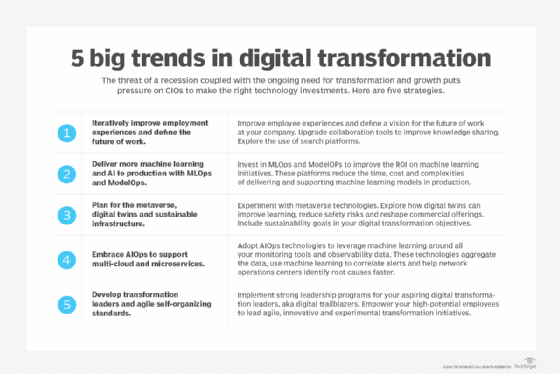
CIO role in driving digital transformation today
Broadly speaking, digital transformation is a practice over 80 years old, involving the use of computer-based technologies to improve an organization's performance. The modern use of the term digital transformation refers to what companies must do today to compete in an environment where the way people work and live is increasingly mediated through digital technologies. It involves the integration of digital technologies into an organization's products, processes, partnerships and strategies.
These technologies include the now widely adopted stalwarts of digital transformation -- cloud, mobile, social media and analytics -- but also a torrent of emergent technologies, including artificial intelligence, IoT, robotic process transformation, digital twins and the so-called immersive technologies: augmented and virtual reality.
Digital transformation projects at companies with traditional business models and large investments in legacy technology are typically complex, large-scale, multiyear, arduous and therefore prone to failure. At many companies, the project requires a wholesale conversion from an analog to a digital business model, and businesses have little choice but to adapt. As digital technologies continue to blur the distinction between the physical and virtual world, finding ways to generate digital revenue is critical to business survival and a responsibility increasingly shared by CIOs with business executives.
Pre-pandemic, the CIO role in digital transformation depended on the following factors:
- types of companies that CIOs worked for;
- where their companies were in terms of operational efficiency and digital customer experience;
- the extent to which their companies were under threat by digital competitors; and
- how receptive the business leadership was to embarking on a digital transformation journey.
A Deloitte global study done in 2018 found that less than 10% of CIOs were getting the company support they felt they needed to lead digital transformation.
The pandemic radically changed that mindset. The "2021 Gartner Board of Directors Survey" found that more than two-thirds of boards of directors (69%) accelerated digital business initiatives in the wake of COVID-19 disruptions; about half anticipated changing their organization's business models as a result of the pandemic. The push to digitally transform remains strong, as does the role of the CIO in leading the charge, according to the following recent stats:
- 53% of CIOs are being asked to accelerate their digital transformation initiatives (PwC);
- 60% of execs list digital transformation as the "most critical growth driver in 2022" (PwC); and
- 80% of business execs said the CIO is the key stakeholder in driving innovation (Deloitte).
Part 2: Qualities of high-performing CIOs
As the CIO role has evolved, the leadership qualities it takes to do the job well have changed too. Since the CIO role's inception, all high-performing CIOs have needed to be able to inspire and lead their IT organizations. Adept CIOs also understood how their IT mission and strategic plans supported the company's mission and strategic goals -- and they made those connections for both their staff and for their C-suite peers. Change management became a critical part of the job as the pace of technology innovation increased. Effective CIOs acted as technology evangelists who focused on the why of technology, not the nuts and bolts of IT implementations. Truly outstanding CIOs used IT to fundamentally transform the businesses they worked for, as explained in the classic study of "renaissance CIOs" by researchers James Spitze and Judith Lee.
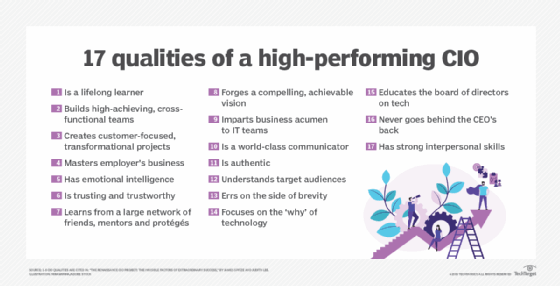
How does the CIO role differ from other technology roles in the C-suite?
As IT became critical to business success, not surprisingly the number of tech-related titles in the C-suite grew. New executive roles created over the past decade or so include but are not limited to the following:
- chief AI officer
- chief data officer
- chief digital officer
- chief experience officer
- chief marketing technologist
- chief privacy officer
There are key differences between the role of the modern CIO and these newly minted IT executive titles, but confusing similarities as well. Making matters more complicated, other traditional IT executive roles like CTO and CISO are also evolving as companies strive to understand how to best manage, protect and exploit their potentially most strategic asset -- information.
Below is a general breakdown of some of the key IT-related C-suite roles beyond the CIO:
- Chief technology officer. The CTO position, under various names, dates to the post-WWII era and even earlier when companies such as AT&T and Xerox supported research labs and put technology directors at the helm. The focus on technology research and development has remained the purview of the CTO, in particular on using new technology to create innovative products. But the CTO role -- and its status, scope and relation to the CIO role -- varies by company, as explained by technology writer George Lawton in his detailed report on the key differences between CIOs and CTOs.
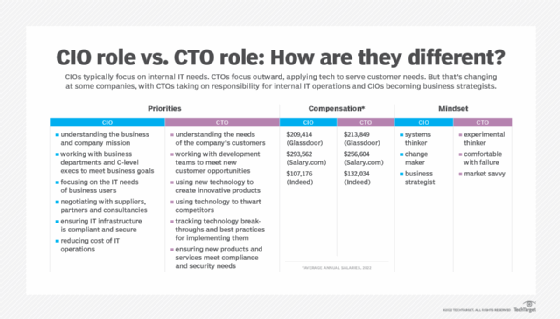
- Chief information security officer. The CISO, whose role dates to the mid-1990s, has gained traction in the organizational hierarchy as cybersecurity has become a top concern for corporate boards. It used to be the case that CISOs reported to the CIO, but that reporting structure can create a conflict of interest, and many security analysts recommend CISOs report directly to the CEO or some other non-IT executive in the C-suite.
- Chief data officer. This position started showing up on organizational charts after the Great Recession in the late 2000s. Created to help companies deal with the increasing regulatory and compliance issues following the financial meltdown, the chief data officer role has shifted at many companies to focus more on data strategy and analytics, and specifically how to use data to make better business decisions and create new sources of revenue. Unlike the CIO, who oversees all IT systems -- including those that support data management -- the chief data officer is responsible for maximizing the value of the data.
- Chief digital officer. Debuting in 2010, the chief digital officer was touted as the C-level executive in charge of digital transformation. The emergence of the role was in part a response to perceptions that CIOs were not up to the task of leading this major paradigm change. Chief digital officer roles tend to mean different things at different companies. One scholarly treatment identifies four types of chief digital officer: evangelist, coordinator, innovator and advocate. Some companies have combined the chief digital and chief information officer roles, using the title CDIO.
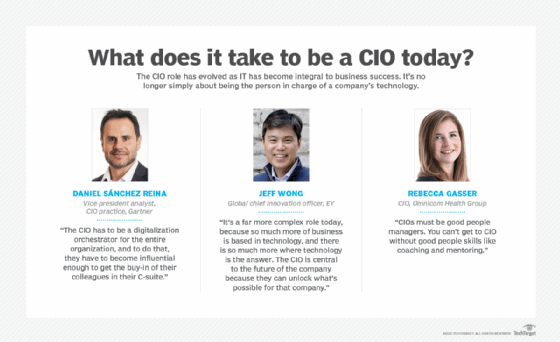
Part 3: What's next for the CIO?
For as long as there have been CIOs, there's been handwringing over what the role entails and how to fill it successfully. "The CIO is dead; long live the CIO!" became a recurring theme, as the pundit class debated whether the CIO should be replaced by another IT expert like the chief data officer or chief digital officer -- or if, in fact, a business executive should become the enterprise's next czar of technology.
The big CIO reset
The relentless pace of technology innovation and change in recent years has quieted that chatter. Everyone from the C-suite to frontline workers now understands on a visceral level that IT is a powerful business tool, and not just for back-office processes or data analysis. As the physical world was overlaid with AI, sensors, computer-generated simulations and other digital technologies, IT became integral to a company's tangible products as well. In an "augmented-product era," as one CIO put it, it's no longer enough for companies to sell a great widget. Success increasingly depends on the widget being Wi-Fi-enabled.
Knowing which technology will help the business remains one of the trickiest aspects of the CIO role. While part of the CIO's job is to identify and employ emerging technologies to win early advantages for their companies, they must do so in a fashion that won't lock in organizations if things change. For example, how much should companies invest in their own AI capabilities -- or should they simply rely on the vendors that are investing fortunes in adding AI into their products? What about distributed ledger technology, or blockchain? A Google search yields thousands of hits on the term, but how it works and how best to use it is still murky. On the horizon are the esoteric but tantalizing possibilities of quantum computing. The looming metaverse will certainly bring more business disruption. Companies will be looking to their CIOs for proofs of concept on these technologies and others still to come.
In short, businesses understand that using technology to drive business objectives requires a depth of expertise. Not just anyone can be in charge, especially during a crisis like the COVID-19 pandemic.
"CIOs helped save many enterprises during the COVID-19 lockdown. They now have the attention of the CEO in a way they haven't before," said the authors of Gartner's 2021 CIO Agenda survey, as reflected in the following findings from the study:
- 66% of CIOs said their relationship with the CEO was stronger and the level of engagement had deepened;
- 70% of CIOs said they were assigned leadership of high-impact initiatives; and
- 80% of CIOs reported an increase in educating business leaders about technology
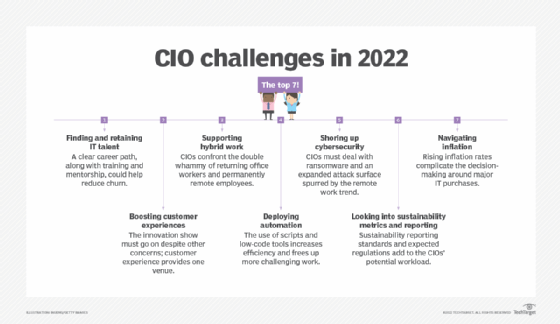
CIO challenges today
But as the purview and clout of CIOs have expanded as a result of their leadership during the pandemic, the challenges of the job remain daunting. CIOs "aren't catching much of a break this year," reported TechTarget Industry Editor John Moore in "Top 7 CIO challenges in 2022 and how to handle them."
"Indeed, 2022 adds the tests of inflation, the back-to-the-office debate and geopolitical turmoil that exacerbates preexisting supply chain issues. Perennial concerns such as cybersecurity and the IT staffing shortage continue unabated. And the pandemic, now in its third year, complicates matters with regional flareups," Moore wrote.
Amid the volatile economic and political conditions, CIOs are finding themselves under pressure to be fiscally prudent and to find technology that can support business agility, according to interviews conducted by Lawton on CIO priorities in 2022. Some of the other trends pushing the CIO agenda include the following:
- adopting a single technology vision;
- preparing for next-generation technology services;
- using the cloud for core business applications;
- building a digital collaboration culture; and
- meeting the challenge of the ever-expanding CIO role.
'Helmsman and engineer'
Amid the uncertainty, what's clear is that CIOs today must help their companies use technology as a business differentiator. They accomplish this by delivering bulletproof and agile systems and services that are inextricably linked to business goals -- in real time, if required -- and by leading their enterprises through the cultural shift required to become digital businesses.
Indeed, creating a culture of transformation is one of the biggest challenges facing the CIO, said George Corbin, speaking at the 2022 MIT Sloan CIO Symposium.
"Culture is an operating system, and to create one [for the current times] you have to recode," said Corbin, who helped lead digital transformations at Mars Inc. and Marriott International and currently serves as the COO of business travel startup Onriva. The biggest change in the role of the CIO, he said, is that the top IT executive is now the company's "transformer in chief."
The job is not about technology transformation per se but about how to "create and lead a movement across the organization -- about how you find your coalitions of the willing," Corbin said. The CIO is the ship's helmsman and its engineer, in his words. "You're up on the bridge navigating the ship and at the same time down in the engine room actively making things work."




